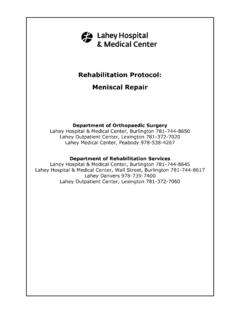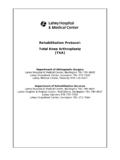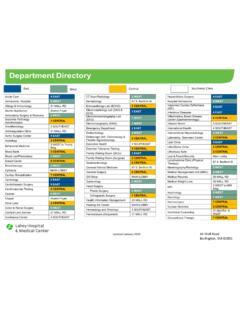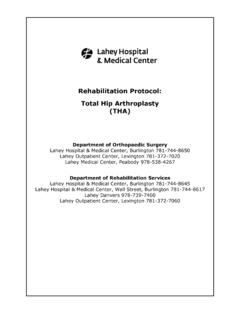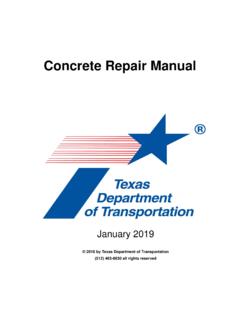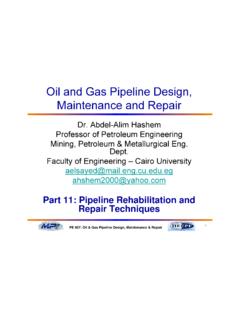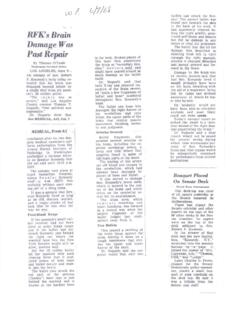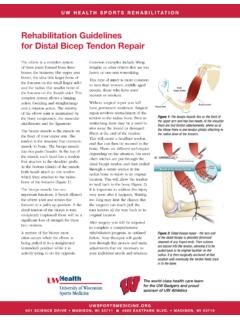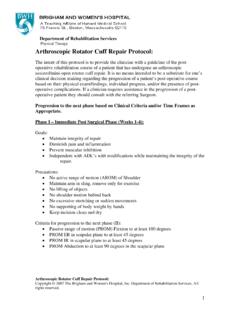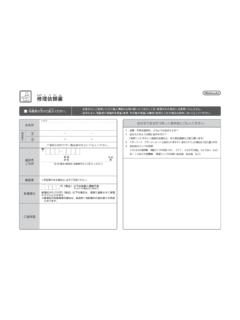Transcription of Rehabilitation Protocol: SLAP repair Superior Labral ...
1 SLAP repair ,Mark. Lemos, MD; David De Baere PT, DPT, 1_2020 Rehabilitation Protocol: SLAP repair Superior Labral Lesion Anterior to Posterior Department of Orthopaedic Surgery Lahey Hospital & Medical Center, Burlington 781-744-8650 Lahey Outpatient Center, Lexington 781-372-7020 Lahey Medical Center, Peabody 978-538-4267 Department of Rehabilitation Services Lahey Hospital & Medical Center, Burlington 781-744-8645 Lahey Hospital & Medical Center, South Bedford Street, Burlington 781-744-8648 Lahey Danvers Rehabilitation , Danvers 978-739-7400 Lahey Outpatient Center, Lexington 781-372-7060 SLAP repair ,Mark. Lemos, MD; David De Baere PT, DPT, 1_2020 2 Overview: The shoulder labrum is a fibrocartilaginous rim attached to the margin of the glenoid cavity.
2 It deepens the cavity by approximately 50%. Approximately 40% of the long head of biceps tendon (LHBT) attaches to the labrum. A Superior labrum anterior and posterior (SLAP) tear involves a tear in the 10 o clock to 2 o clock positions on the glenoid and frequently involves the LHBT. A SLAP tear can be caused by an acute injury such as a fall onto an outstretched arm, a shoulder dislocation or a motor vehicle accident or it may be due to repetitive overhead activities. Labral fraying is also part of the normal aging process. Surgical intervention may involve debridement or repair depending on the size of the tear, the mechanism of injury and the age of the patient.
3 The LHBT may be reattached, or may have undergone a tenodesis or tenotomy. It is important for the therapist to work closely with the surgeon to understand the surgical intervention, which will guide the Rehabilitation 1 Burns, JP et al. Superior Labral tears: repair versus biceps tenodesis J Shoulder Elbow Surg 2011 Mar; 20(2 suppl): S2-8 SLAP repair ,Mark. Lemos, MD; David De Baere PT, DPT, 1_2020 3 Phase I Protective Phase: 0 4 Weeks Weeks 0 2 Cryotherapy AROM C-spine, wrist and hand PROM elbow flexion, supination and pronation as tolerated Weeks 3 4 Continue cryotherapy PROM/AAROM: Flexion as tolerated Abduction to 80 ER in neutral as tolerated ER/IR in scapular plane: ER: 30 IR: 60 Therapeutic Exercise Active: Scapular retraction C-spine, wrist and hand Ball squeezes Scapular Rhythmic stabilization (RS) Walking, stationary bike wearing sling 3 Weeks: Sub-maximal isometric exercise at 0 abduction.
4 Flexion Abduction IR/ER Overhead pulley/Wand AAROM 4 weeks D/C sling at 4 weeks unless advised by surgeon Goals: Protect anatomic repair Allow healing of repaired labrum Initiate early protected and restricted range of motion Minimize muscular atrophy Decrease pain/inflammation Promote dynamic stability Precautions Sling for 4 weeks during day and at night NO active ER, extension or elevation NO isolated activation of biceps NO jogging, running, jumping NO long head bicep tension for 6 weeks to protect repaired tissues- avoid long lever arm with shoulder flexion NO resisted supination or resisted elbow flexion NO early pendulums Precautions: SLAP repair ,Mark.
5 Lemos, MD; David De Baere PT, DPT, 1_2020 4 Phase II Intermediate Phase (5-7 weeks after surgery) Weeks 5 7 D/C Sling after 4 weeks unless advised by surgeon PROM AAROM AROM (with scapulohumeral rhythm) Continue AAROM overhead pulleys/wand Shoulder flexion as tolerated (initiate in supine) Abduction/Scaption as tolerated (initiate in sidelying) ER at 0 abduction as tolerated ER/IR in scapular plane: ER: 50 IR: 60 Gentle IR behind back Therapeutic Exercise Active-assisted progressing to active forward flexion and scaption with scapulohumeral rhythm Sidelying ER 6 weeks Theraband IR/ER Latissimus strengthening below 90 elevation (never behind head)
6 Begin light and gradual ER at 90 abduction progressing to 45 ER Initiate AROM elbow Prone row Prone extension Prone T 7 weeks Deloaded Scapular Stabilization Goals Gradual increase in ROM Improve strength Decrease pain/inflammation Promote dynamic stability Precautions Gentle mid-range ER in scapular plane, gradually progress to ER in abduction Avoid resisted supination during ER to protect biceps Progress active motion only when patient demonstrates scapulohumeral rhythm No biceps strengthening until 6 weeks SLAP repair ,Mark. Lemos, MD; David De Baere PT, DPT, 1_2020 5 Phase III Early Strengthening (8 12 Weeks after surgery) Week 8-9: Gradually progress to Full ROM: G/H mobilization as needed Flexion to 180 ER to 90 at 90 abduction IR full at 90 abduction Therapeutic Exercise Sleeper stretch if posterior capsule tightness ER in scapular plane gradually progress to ER in abduction Wall slide IR behind back Horizontal adduction Sidelying IR at 90 flexion PNF patterns with tubing Week 9-10: Hands behind head starts Theraband exercises: o Scapular Stab, ER, IR forward, punch, shrug, dynamic hug, W s Week 11-12.
7 Seated row Dynamic exercises Continue phase II exercises Progressive Resistive Exercises 1-3 lb. as tolerated Prone Y Continue rhythmic stab Continue proprioception drills Scapulohumeral rhythm exercises Goals Protect repair Gradually restore full range of motion Increase strength Improve neuromuscular control Enhance proprioception and kinesthesia Precautions Gentle mid-range ER in scapular plane, gradually progress to ER in abduction Continue to protect biceps Progress only when patient demonstrates scapulohumeral rhythm Gentle biceps strengthening only SLAP repair ,Mark. Lemos, MD; David De Baere PT, DPT, 1_2020 6 Phase IV (12-16 Weeks after surgery) Weeks 12-16 Full ROM Continue previous stretches Therapeutic Exercise Continue phase III exercises Progress bicep curls Plyometric exercises: Rebounder throws arm at side Wall dribbles overhead Goals Full ROM Improve: strength, power and endurance Improve neuromuscular control Improve dynamic stability Precautions NOT ready for return to sports Weight training precautions.
8 Never drop elbows below plane of body Always see elbows No lat pulls behind head Continue to avoid excessive or forceful extension and ER SLAP repair ,Mark. Lemos, MD; David De Baere PT, DPT, 1_2020 7 Phase V (16-20 Weeks after surgery) Weeks 16-20 Full ROM Therapeutic Exercise Continue above Plyometric Exercise: Add rebounder throws with decelerations Wall dribbles at 90 Wall dribble circles Interval sports programs can begin per MD clearanceGoals Progressively increase activities to prepare patient for unrestricted functional return Precautions Weight training precautions SLAP repair ,Mark. Lemos, MD; David De Baere PT, DPT, 1_2020 Rehabilitation Protocol for Superior Labral Lesion Anterior to Posterior: Summary Table Post op Phase/Goals Range of Motion Therapeutic Exercise Precautions Phase I 0 - 4 weeks after surgery Goals.
9 Protect anatomic repair Allow healing of repaired labrum Initiate early protected and restricted range of motion Minimize muscular atrophy Decrease pain/inflammation Promote dynamic stability Weeks 0-2 Cryotherapy AROM C-spine, wrist and hand PROM elbow flexion, supination and pronation as tolerated Sling for 4 weeks during day and at night NO active ER, extension or elevation NO isolated activation of biceps NO jogging, running, jumping NO long head bicep tension for 6 weeks to protect repaired tissues avoid long lever arm with shoulder flexion NO resisted supination and resisted elbow flexion NO early pendulums Weeks 3-4 PROM/AAROM Flexion as tolerated Abduction to 80 ER in neutral as tolerated ER/IR in scapular plane: ER: 30 IR : 60 -Passive and Active-assisted ROM: Active: -Scapular retraction -C-spine, wrist and hand AROM -Ball squeezes -Scapular Rhythmic stabilization (RS) -Walking, Stationary Bike wearing sling 3 weeks: -Sub maximal isometric exercise at 0 of abduction.
10 Flexion, abd, IR & ER 4 weeks Overhead pulley/Wand AAROM SLAP repair ,Mark. Lemos, MD; David. De Baere PT, DPT, 1_2020 9 Phase II 5 to 7 weeks after surgery Goals: Gradual increase in ROM Improve strength Decrease pain/inflammation Promote dynamic stability Flexion as tolerated (initiate in supine) Scaption as tol (initiate in sidelying) Abduction as tol. (initiate in sidelying) ER in neutral as tol. ER/IR in scapular plane ER: 50 IR : 60 At 6 weeks begin light and gradual ER at 90 abduction progressing to 45 ER D/C Sling at 4 weeks per surgeon clearance Continue Phase I exercises PROM AAROM AROM (with scapulohumeral rhythm) Sidelying ER Continue AAROM overhead pulleys/wand Shoulder flexion as tolerated (initiate in supine) Abduction/Scaption as tolerated (initiate in sidelying) ER at 0 abduction as tolerated Gentle IR behind back 6 weeks Prone.

